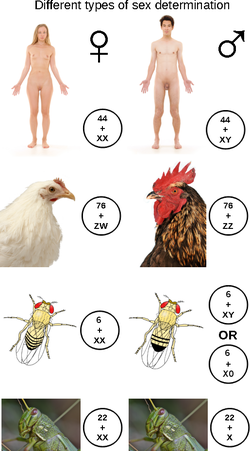
Back نظام تحديد الجنس Arabic লিঙ্গ নির্ধারণ ব্যবস্থা Bengali/Bangla Sistem određivanja spola BS Determinació del sexe Catalan توخمە کڕۆمۆسۆم CKB Určení pohlaví Czech Geschlechtsdetermination German Σύστημα φυλοκαθορισμού Greek Sistema de determinación del sexo Spanish روش تعیین جنسیت Persian

A sex-determination system is a biological system that determines the development of sexual characteristics in an organism.[1] Most organisms that create their offspring using sexual reproduction have two common sexes, males and females, and in other species, there are hermaphrodites, organisms that can function reproductively as either female or male, or both.[2]
There are also some species in which only one sex is present, temporarily or permanently. This can be due to parthenogenesis, the act of a female reproducing without fertilization. In some plants or algae the gametophyte stage may reproduce itself, thus producing more individuals of the same sex as the parent.
In some species, sex determination is genetic: males and females have different alleles or even different genes that specify their sexual morphology. In animals this is often accompanied by chromosomal differences, generally through combinations of XY, ZW, XO, ZO chromosomes, or haplodiploidy. The sexual differentiation is generally triggered by a main gene (a "sex locus"), with a multitude of other genes following in a domino effect.
In other cases, the sex of a fetus is determined by environmental variables (such as temperature). The details of some sex-determination systems are not yet fully understood.
Some species such as various plants and fish do not have a fixed sex and instead go through life cycles and change sex based on genetic cues during corresponding life stages of their type. This could be due to environmental factors such as seasons and temperature. In some gonochoric species, a few individuals may have conditions that cause a mix of different sex characteristics.[3]
- ^ Schnebly, Risa Aria (2021). "Sex Determination in Humans". The Embryo Project Encyclopedia. Retrieved 6 July 2022.
- ^ Rosenfield KA (2018). "Hermaphrodite". In Vonk J, Shackelford T (eds.). Encyclopedia of Animal Cognition and Behavior. Cham: Springer International Publishing. pp. 1–2. doi:10.1007/978-3-319-47829-6_329-1. ISBN 978-3-319-47829-6.
- ^ Minelli A, Fusco G (2019). The Biology of Reproduction. Cambridge University Press. pp. 116–117. ISBN 978-1108499859. Archived from the original on 11 October 2020. Retrieved 11 October 2020.